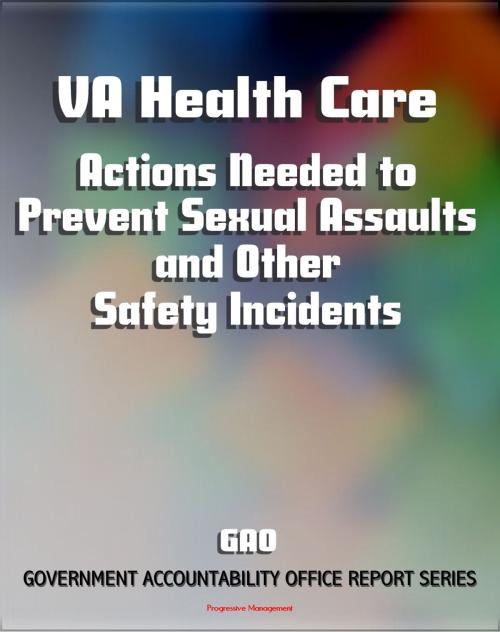VA Health Care: Actions Needed to Prevent Sexual Assaults and Other Safety Incidents - 2011 Government Accountability Office (GAO) Report
Nonfiction, Social & Cultural Studies, Political Science, Health & Well Being, Health| Author: | Progressive Management | ISBN: | 9781458109316 |
| Publisher: | Progressive Management | Publication: | June 8, 2011 |
| Imprint: | Smashwords Edition | Language: | English |
| Author: | Progressive Management |
| ISBN: | 9781458109316 |
| Publisher: | Progressive Management |
| Publication: | June 8, 2011 |
| Imprint: | Smashwords Edition |
| Language: | English |
The Government Accountability Office (GAO) investigated the handling of sexual assaults at Department of Veterans Affairs residential programs and mental health units and has made a number of recommendations to the department. Changes in patient demographics present unique challenges for VA in providing safe environments for all veterans treated in Department of Veterans Affairs (VA) facilities. GAO was asked to examine whether or not sexual assault incidents are fully reported and what factors may contribute to any observed underreporting, how facility staff determine sexual assault-related risks veterans may pose in residential and inpatient mental health settings, and precautions facilities take to prevent sexual assaults and other safety incidents. GAO reviewed relevant laws, VA policies, and sexual assault incident documentation from January 2007 through July 2010 provided by VA officials and the VA Office of the Inspector General (OIG). In addition, GAO visited and reviewed portions of selected veterans' medical records at five judgmentally selected VA medical facilities chosen to ensure the residential and inpatient mental health units at the facilities varied in size and complexity. Finally, GAO spoke with the four Veterans Integrated Service Networks (VISN) that oversee these VA medical facilities.
GAO found that many of the nearly 300 sexual assault incidents reported to the VA police were not reported to VA leadership officials and the VA OIG. Specifically, for the four VISNs GAO spoke with, VISN and VA Central Office officials did not receive reports of most sexual assault incidents reported to the VA police. Also, nearly two-thirds of sexual assault incidents involving rape allegations originating in VA facilities were not reported to the VA OIG, as required by VA regulation. In addition, GAO identified several factors that may contribute to the underreporting of sexual assault incidents including unclear guidance and deficiencies in VA's oversight. VA does not have risk assessment tools designed to examine sexual assault related risks veterans may pose. Instead, VA staff at the residential programs and inpatient mental health units GAO visited said they examine information about veterans' legal histories along with other personal information as part of a multidisciplinary assessment process. VA clinicians reported that they obtain legal history information directly from veterans, but these self-reported data are not always complete or accurate. In reviewing selected veterans' medical records, GAO found that complete legal history information was not always documented. In addition, VA has not provided clear guidance on how such legal history information should be collected or documented. GAO found significant weaknesses in the implementation of these physical security precautions at these VA facilities, including poor monitoring of surveillance cameras, alarm system malfunctions, and the failure of alarms to alert both VA police and clinical staff when triggered. Inadequate system installation and testing procedures contributed to these weaknesses. Further, facility officials at most of the locations GAO visited said the VA police were understaffed. Such weaknesses could lead to delayed response times to incidents and seriously erode efforts to prevent or mitigate sexual assaults and other safety incidents. GAO recommends that VA improve both the reporting and monitoring of sexual assault incidents and the tools used to identify risks and address vulnerabilities at VA facilities. VA concurred with GAO's recommendations and provided an action plan to address them.
The Government Accountability Office (GAO) investigated the handling of sexual assaults at Department of Veterans Affairs residential programs and mental health units and has made a number of recommendations to the department. Changes in patient demographics present unique challenges for VA in providing safe environments for all veterans treated in Department of Veterans Affairs (VA) facilities. GAO was asked to examine whether or not sexual assault incidents are fully reported and what factors may contribute to any observed underreporting, how facility staff determine sexual assault-related risks veterans may pose in residential and inpatient mental health settings, and precautions facilities take to prevent sexual assaults and other safety incidents. GAO reviewed relevant laws, VA policies, and sexual assault incident documentation from January 2007 through July 2010 provided by VA officials and the VA Office of the Inspector General (OIG). In addition, GAO visited and reviewed portions of selected veterans' medical records at five judgmentally selected VA medical facilities chosen to ensure the residential and inpatient mental health units at the facilities varied in size and complexity. Finally, GAO spoke with the four Veterans Integrated Service Networks (VISN) that oversee these VA medical facilities.
GAO found that many of the nearly 300 sexual assault incidents reported to the VA police were not reported to VA leadership officials and the VA OIG. Specifically, for the four VISNs GAO spoke with, VISN and VA Central Office officials did not receive reports of most sexual assault incidents reported to the VA police. Also, nearly two-thirds of sexual assault incidents involving rape allegations originating in VA facilities were not reported to the VA OIG, as required by VA regulation. In addition, GAO identified several factors that may contribute to the underreporting of sexual assault incidents including unclear guidance and deficiencies in VA's oversight. VA does not have risk assessment tools designed to examine sexual assault related risks veterans may pose. Instead, VA staff at the residential programs and inpatient mental health units GAO visited said they examine information about veterans' legal histories along with other personal information as part of a multidisciplinary assessment process. VA clinicians reported that they obtain legal history information directly from veterans, but these self-reported data are not always complete or accurate. In reviewing selected veterans' medical records, GAO found that complete legal history information was not always documented. In addition, VA has not provided clear guidance on how such legal history information should be collected or documented. GAO found significant weaknesses in the implementation of these physical security precautions at these VA facilities, including poor monitoring of surveillance cameras, alarm system malfunctions, and the failure of alarms to alert both VA police and clinical staff when triggered. Inadequate system installation and testing procedures contributed to these weaknesses. Further, facility officials at most of the locations GAO visited said the VA police were understaffed. Such weaknesses could lead to delayed response times to incidents and seriously erode efforts to prevent or mitigate sexual assaults and other safety incidents. GAO recommends that VA improve both the reporting and monitoring of sexual assault incidents and the tools used to identify risks and address vulnerabilities at VA facilities. VA concurred with GAO's recommendations and provided an action plan to address them.















